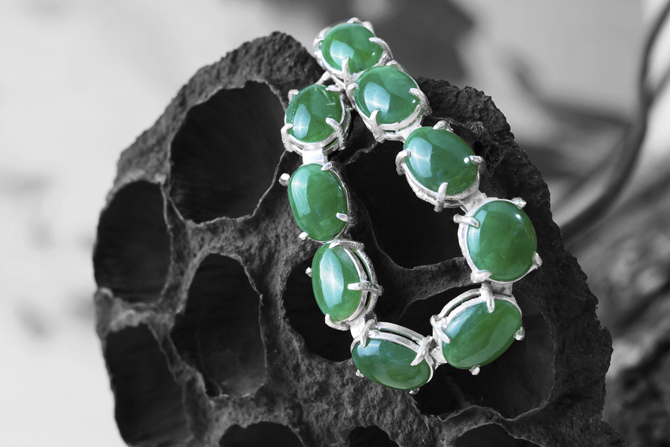04 February 2014
Jadeite Jade Identification and Investment

As jadeite increasingly piques the interest of collectors with its appreciation and investment value, learn about the things to note when purchasing jadeite from Professor Mimi Ou-yang of the H.K. Institute of Gemmology.
Although the time when jadeite, one of the popular collectible gemstones in the Chinese culture, was first imported to China is often disputable, Professor Ou-yang believes the Ming Dynasty is the time suggested by the historical archive on the beginning of jadeite trade: "No hints of jadeite have been traced in excavated artefacts or imperial collectibles dated prior to the Ming Dynasty, not even among the grave goods at the prominent Ming Dynasty Tombs. Written record of jadeite in China didn't appear until 1638-1639, when travel writer and geographer of the Ming Dynasty, Xu Xia-ke, described in his travelogue his own witness of the processing and brisk trade of jadeite in Tengchong county, western Yunnan province."
Colour, Transparency, Texture, Craftsmanship
While jadeite is found in Japan, Russia and Central America, Burma produces the greatest amount of jadeite that reaches collectible value. And it is on the internationally acknowledged quality valuation methodology called '4C2T1V' that practitioners rely to appraise the gemstone:
4C – colour, craftsmanship, clarity, crack
2T – transparency, texture
1V – volume
It is important to note that although this methodology cannot be used directly for quotation purpose, it can aid the investor's understanding of the quality of the jadeite before further assessing its value according to market price. There is an order to follow when adopting the '4C2T1V' methodology: evaluation needs to begin from the colour, and then the transparency and texture, before proceeding with the assessment of craftsmanship; the actual value of the jadeite is decided upon the further subtraction of value from the level of clarity, possible cracks and the size.
Among the colours of white, lavender, green, yellow, red and black, Professor Ou-yang reckons the colour of a jadeite is more a personal preference than an indication in investment value. "A jadeite could sometimes exhibit multiple colours, and its investment value can be affected by the evenness of colour distribution. Even for the popular green jadeite, there exists a panoply of definitions of green from pea-green, Huangyang green, green, to apple green, although emerald remains popularly recognised as the ideal colour. The transparency and texture of a jadeite, meanwhile, are dependent on the size, arrangement and transparency of the crystals inside the jadeite."
In addition, a great range of terminology exists in gemmology to describe the quality of the jadeite. "The 'lao keng zhong' (or 'old mine') type of jadeite is darker in colour with fine translucency; the 'gan qing zhong' type of jadeite features a full-bodied green, black spots and high opacity; the 'mo qu' (or 'ink jade') type of jadeite is dark as ink, even when under bounce light, but unveils a dark green under transmission light, and features a fine texture and high transparency. The list of terminology includes 20 to 30 ways of description but I'm not going to list them all out here."
Investment Tips on Burmese Jadeite
The price of Burmese jadeite experienced volatile fluctuations when the country's government closed all jade mines and ceased all public auctions of the gemstone in 2012, although the price has recently resumed to the normal level. As an investor, it is wise to learn how to buy in such a market situation. "On my field trip to a mine in Burma in 1999, I was told by the miners that there was only one jadeite for every 10,000 stones mined, and only one that is green in every 10,000 pieces of jadeite. This finding, while not strictly an official one, reflects the fact that 70% of the jadeite mined today is of low quality – jadeite that has little value appreciation potential and bears the risk of depreciation. When investing, invest in jadeite that is accredited as a gemstone. Be sure to buy only the best quality jadeite gemstone and not opt for the inexpensive ones. It's equally important to learn more about its production quantity and therefore its rarity," said Professor Ou-yang.
"Professional identification skills and know-how are the prerequisite for jadeite investment. Refrain from following the opinion of amateurs as only with professional knowledge can you rationally identify gemstones with collectible value and appreciation potential, as well as to best grasp investment opportunities and minimise loss. In cases where professional identification is necessary, the Hong Kong Gems Laboratory is where you would want to visit." In terms of the ways for jadeite enthusiasts to equip themselves with identification know-how, Professor Ou-yang recommends as such: "If time allows, signing up for a course in professional jadeite identification may be a good idea, as you'll be able to exchange ideas and experiences with your classmates and learn from/with each other. Alternatively, you may take your time to learn by reading reference materials or illustrated books at home."
Special Thanks:
Professor Mimi Ou-yang, the H.K. Institute of Gemmology
Smart Decisions

